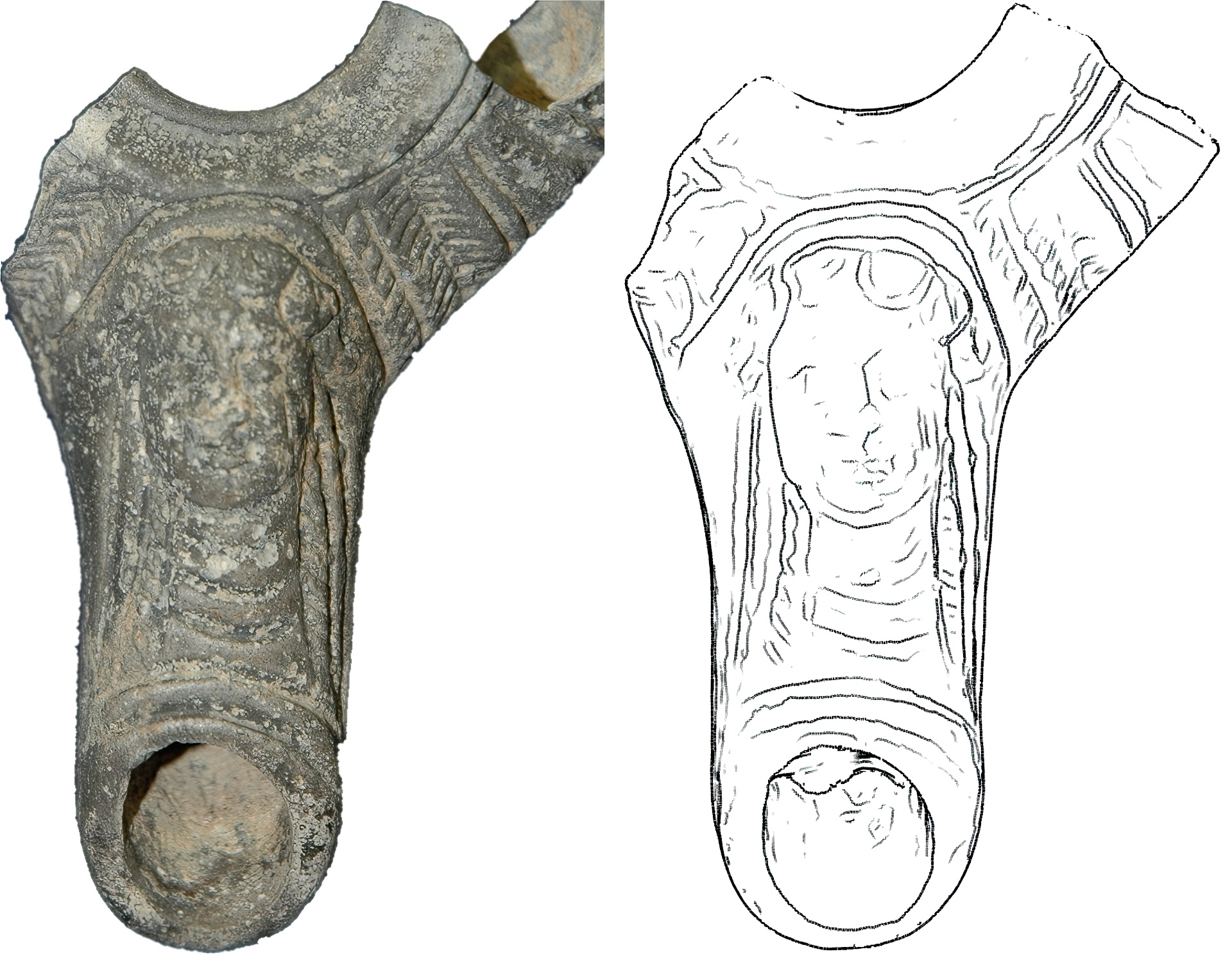“Demarcating curves for shape illustration”
Conference:
Type(s):
Title:
- Demarcating curves for shape illustration
Session/Category Title: Non-photorealistic rendering
Presenter(s)/Author(s):
Abstract:
Curves on objects can convey the inherent features of the shape. This paper defines a new class of view-independent curves, denoted demarcating curves. In a nutshell, demarcating curves are the loci of the “strongest” inflections on the surface. Due to their appealing capabilities to extract and emphasize 3D textures, they are applied to artifact illustration in archaeology, where they can serve as a worthy alternative to the expensive, time-consuming, and biased manual depiction currently used.
References:
1. Bartesaghi, A., and Sapiro, G. 2001. A system for the generation of curves on 3D brain images. Human brain mapping 14, 1, 1–15.Google Scholar
2. Brown, B., Toler-Franklin, C., Nehab, D., Burns, M., Dobkin, D., Vlachopoulos, A., Doumas, C., Rusinkiewicz, S., and Weyric, T. 2008. A system for high-volume acquisition and matching of fresco fragments: Reassembling theran wall paintings. ACM Trans. Graph. 27, 3. Google ScholarDigital Library
3. Cole, F., Golovinskiy, A., Limpaecher, A., Barros, H., Finkelstein, A., Funkhouser, T., and Rusinkiewicz, S. 2008. Where do people draw lines? ACM Trans. Graph. 27, 3. Google ScholarDigital Library
4. DeCarlo, D., and Rusinkiewicz, S. 2007. Highlight lines for conveying shape. In NPAR, 63–70. Google Scholar
5. DeCarlo, D., Finkelstein, A., Rusinkiewicz, S., and Santella, A. 2003. Suggestive contours for conveying shape. ACM Transactions on Graphics 22, 3, 848–855. Google ScholarDigital Library
6. DeCarlo, D., Finkelstein, A., and Rusinkiewicz, S. 2004. Interactive rendering of suggestive contours with temporal coherence. In NPAR, 15–24. Google Scholar
7. Deussen, O., Hiller, S., van Overveld, C., and Strothotte, T. 2000. Floating points: A method for computing stipple drawings. Computer Graphics Forum 19, 3, 40–51.Google ScholarCross Ref
8. Do Carmo, M. P. 1976. Differential geometry of curves and surfaces. Prentice-Hall.Google Scholar
9. Gooch, B., Sloan, P. J., Gooch, A., Shirley, P., and Riesenfeld, R. F. 1999. Interactive technical illustration. In Symp. on Interactive 3D Graphics, 31–38. Google Scholar
10. Hertzmann, A., and Zorin, D. 2000. Illustrating smooth surfaces. In ACM SIGGRAPH, 517–526. Google Scholar
11. Interrante, V., Fuchs, H., and Pizer, S. 1995. Enhancing transparent skin surfaces with ridge and valley lines. In IEEE Visualization, 52–59. Google Scholar
12. Iverson, L. A., and Zucker, S. W. 1995. Logical/linear operators for image curves. IEEE Trans. Pattern Anal. Machine Intell. 17, 10 (October), 982–996. Google ScholarDigital Library
13. Judd, T., Durand, F., and Adelson, E. 2007. Apparent ridges for line drawing. ACM Trans. Graph. 26, 3, 19:1–19:7. Google ScholarDigital Library
14. Kalnins, R. D., Markosian, L., Meier, B. J., Kowalski, M. A., Lee, J. C., Davidson, P. L., Webb, M., Hughes, J. F., and Finkelstein, A. 2002. WYSIWYG NPR: drawing strokes directly on 3D models. In ACM SIGGRAPH, 755–762. Google Scholar
15. Kindlmann, G., Whitaker, R., Tasdizen, T., and Moller, T. 2003. Curvature-Based Transfer Functions for Direct Volume Rendering: Methods and Applications. In IEEE Vis., 67–76. Google Scholar
16. Koenderink, J. J. 1984. What does the occluding contour tell us about solid shape? Perception 13, 3, 321–330.Google ScholarCross Ref
17. Koenderink, J. J. 1990. Solid shape. MIT Press. Google Scholar
18. Koller, D., Trimble, J., Najbjerg, T., Gelfand, N., and Levoy, M. 2006. Fragments of the city: Stanford’s digital forma urbis romae project. J. of Roman Arch. 61, 237–252.Google Scholar
19. Lee, Y., Markosian, L., Lee, S., and Hughes, J. F. 2007. Line drawings via abstracted shading. ACM Trans. Graph. 26, 3, 18:1–18:5. Google ScholarDigital Library
20. Maaten, L. J. P., Boon, P. J., Paijmans, J. J., Lange, A. G., and Postma, E. O. 2006. Computer vision and machine learning for archaeology. In Computer Applications and Quantitative Methods in Archaeology, 112–130.Google Scholar
21. Mehlum, E., and Tarrou, C. 2006. Invariant smoothness measures for surfaces. Advances in Comp. Math. 8, 1-2, 49–63.Google Scholar
22. Ohtake, Y., Belyaev, A., and Seidel, H. P. 2004. Ridge-valley lines on meshes via implicit surface fitting. ACM Trans. Graph. 23, 3, 609–612. Google ScholarDigital Library
23. Page, D., Koschan, A., Abidi, M., and Overhiolt, J. 2006. Ridge-valley path planning for 3D terrains. In IEEE Int. Conf. on Robotics and Automation, 119–124.Google Scholar
24. Pauly, M., Keiser, R., and Gross. 2003. Multi-scale feature extraction on point-sampled surfaces. Computer Graphics Forum 22, 3, 281–290.Google ScholarCross Ref
25. Pearson, D. E., and Robinson, J. A. 1985. Visual communication at very low data rates. Proceedings of IEEE 73, 795–812.Google ScholarCross Ref
26. Pennec, X., Ayache, N., and Thirion, J. 2000. Landmark-based registration using features identified through differential geometry. In Handbook of Medical Imaging. 499–513. Google Scholar
27. Rushmeier, H. 2005. Eternal Egypt: experiences and research directions. In Modeling and Visualization of Cultural Heritage, 22–27.Google Scholar
28. Rusinkiewicz, S., Burns, M., and DeCarlo, D. 2006. Exaggerated shading for depicting shape and detail. ACM Transactions on Graphics (Proc. SIGGRAPH) 25, 3 (July). Google ScholarDigital Library
29. Rusinkiewicz, S. 2004. Estimating curvatures and their derivatives on triangle meshes. In Proc. 3D Data Processing, Visualization and Transmission, 486–493. Google ScholarDigital Library
30. Saito, T., and Takahashi, T. 1990. Comprehensible rendering of 3D shapes. In ACM SIGGRAPH, 197–206. Google Scholar
31. Stern, E. 1995. Excavations at Dor. Jerusalem: Institute of Archaeology of the Hebrew University.Google Scholar
32. Strothotte, T., and Schlechtweg, S. 2002. Non-Photorealistic Computer Graphics. Morgan Kaufmann. Google Scholar
33. Stylianou, G., and Farin, G. 2004. Crest lines for surface segmentation and flattening. IEEE Trans. on Visualization and Computer Graphics 10, 5, 536–544. Google ScholarDigital Library
34. Xie, X., He, Y., Tian, F., and Seah, H.-S. 2007. An effective illustrative visualization framework based on photic ex-tremum lines (PELs). IEEE Trans. on Visualization and Computer Graphics 13, 6, 1328–1335. Google ScholarDigital Library
35. Yoshizawa, S., Belyaev, A., and Seidel, H. P. 2005. Fast and robust detection of crest lines on meshes. In ACM Symposium on Solid and Physical Modeling, 227–232. Google Scholar





